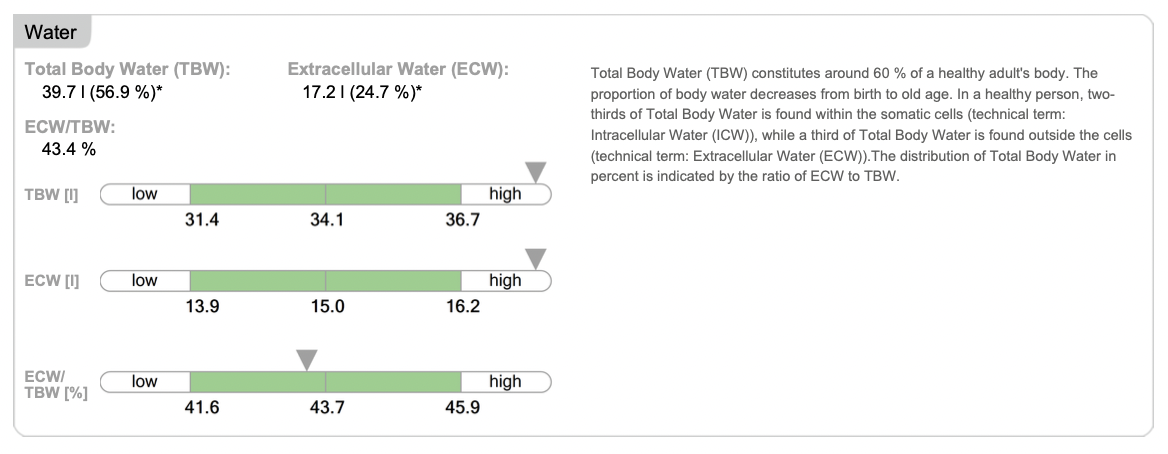Water is essential for life and that includes the human body! It is central to every chemical process that takes place in the body and has a multitude of important roles.
This article provides a brief overview of the role of body water and what you need to know when assessing body composition.
What role does water play in the body?
The human body cannot survive more than a few days without water because it so tightly regulated.
The body’s water is an essential medium for most processes that take place and is necessary for life-critical functions as well as optimal health. Water enables numerous substances to be transported around the body, delivering oxygen and nutrients throughout the body, whilst excreting toxic waste.
Body water is also critical for the regulation and management of body temperature and blood pressure as well as lubricating joints and hydrating skin.
As part of our body composition assessment service, one area of assessment is that of total body water, extracellular water and the extra cellular water to total body water ratio.
This is demonstrated in the image below, taken from an example body composition report.
What is total body water?
Total body water is the total volume of water within the body and is a term referred to within body composition measurements. Water is present throughout the body – from skin, to every organ, muscle and even bone.
Total body water can be further categorised into extracellular water or intracellular water, depending on where it is found within the body: extracellular water is found outside of the cells whereas intracellular water is found within the cells.
What should your body water percentage be?
Total body water usually makes up approximately 50-60% of an adult’s body weight, however it may range from 45% to 75%. This variation in range is due to factors such as gender, age and differences in body composition.
In general, healthy men tend to have larger amounts of total body water than women due to their larger body size and muscle mass.
Additionally, if an individual has higher levels of muscle, then they will have proportionately more body water, or if they have more fat then they will have proportionately less body water. Therefore, someone who is very overfit may have a body weight percentage of 50% versus a healthy lean person with high muscle mass may have a body weight percentage of 70%.
Body water percentage also decreases by age. This may be due to a combination of factors, such as an overall decline in total body water volume associated with aging, or due to an increase in fat mass and loss of muscle mass that occurs with increased age for many adults (Chumlea et al. 1999).
Different body parts, different body water percentages?
Each tissue within the body has a different percentage of water, depending upon its function. For instance, the lungs are approximately 82% water, the muscles and kidneys approximately 80%, the brain and heart approximately 73% water and even the bones are approximately 25% water. Fatty tissue has a considerably lower water percentage (10-40%) than muscle tissue (80%).
What is extracellular water (ECW)?
Extracellular water is found outside of the cell. It is important for providing the nutrients and substances necessary for the function of that tissue. It is rich in the electrolyte sodium and low in the electrolyte potassium. Extracellular water contributes to approximately 40% of total body water. Extracellular water makes up: interstitial fluid (the fluid that provides nutrients and oxygen to all of the cells whilst removing waste), blood plasma (the liquid part of the blood that all the blood cells are carried in) and transcellular fluid (fluid that lubricates body joints and provides nutrients).
What is intracellular water (ICW)?
Intracellular water is found inside the cell. It contains dissolved substances and proteins which are necessary for all the vital cellular processes to take place. It is rich in the electrolyte potassium and low in the electrolyte sodium. Intracellular water contributes to approximately 60% of total body water.
What is a healthy water balance?
For healthy body water levels, the most important factor is balance, which requires maintaining a ratio of approximately 3:2 ICW:ECW. And fortunately for you, your body has inbuilt mechanisms to tightly regulate this for you. Hence why you become thirsty and go to the loo!
Inadequate water intake can lead to dehydration and a host of unwanted effects: headaches, constipation, reduced athletic performance and recovery, reduced mood and cognitive performance and confusion/delirium (Popkin et al. 2010). However, too much water can have an adverse effect on bodily functions too.
What factors influence total body water?
Under normal circumstances total body water levels are tightly regulated – through the management of the pressure of intra and extra cellular fluid (comprising the intra and extra cellular water). Chemical messengers, some of which are released from the kidneys either inform us to drink more, excrete more water or reabsorb more water (concentrated urine).
Total body water volume can be impacted by climate, salt intake, hormone levels, carbohydrate intake, level of physical activity and certain substances such as alcohol and caffeine. Total body water volume can also be impacted by health conditions such as kidney and liver disease, diabetes, cancer and heart disease (Zhang et al. 2019).
Research indicates that increased extracellular water (ECW) may be associated with excess body fat (Lichtenbelt et al. 1999), inflammation and water retention. On the other hand, a higher level of intracellular water (ICW) to lean muscle ratio may be associated with greater muscle strength (Serra-Prat et al. 2019).
How do I maintain a healthy water percentage?
Maintaining a healthy water percentage requires an appropriate amount of daily water consumption (neither too much nor too little). The volume of water you require will depend upon your age, gender, weight, health and activity level and will also slightly vary day to day. What you consume also has an impact since some foods have much higher volumes of water.
How would my body water percentage be assessed?
Body composition measurements, such as bioimpedance analysis (BIA) is a quick, precise and non-invasive way of measuring TBW and percentage of ECW. This is the methodology we use in our clinic. For more information CLICK HERE.
Key take aways:
Body water is crucial for life and health: it enables numerous substances to be transported around the body and excretes toxic waste. Body water is also critical for the regulation and management of body temperature and blood pressure as well as lubricating joints and hydrating skin.
Total body water usually makes up approximately: 50-60% of an adult’s body weight, however it may range from 45% to 75%. This variation in range is due to factors such as gender, age and differences in body composition.
Total body water can be categorised into: intracellular water (ICW) found inside the cell and extracellular water (ECW) found outside of the cell.
Various factors influence TBW: such as climate, salt intake, level of physical activity, hormones, carbohydrate intake and certain substances such as alcohol and caffeine. Health conditions such as kidney and liver disease, diabetes, cancer and heart disease also impact TBW.
If you are interested in performing a body composition with one of our nutritionists, please go to our main body composition test page.
References
- Chumlea et al. (1999). Total body water data for white adults 18 to 64 years of age: the Fels longitudinal study.
- Serra-Prat et al. (2019). Intracellular water content in lean mass is associated with muscle strength, functional capacity and frailty in community-dwelling elderly individuals. A cross-sectional study.
- Lichtenbelt et al. (1999). Increased extracellular water compartment, relative to intracellular compartment, after weight reduction.
- Zhang et al. (2019). Association between the content of intracellular and extracellular fluid and the amount of water intake among Chinese college students.
- Popkin et al (2010). Water, hydration and health



